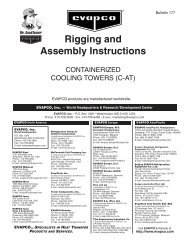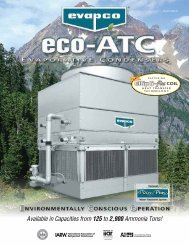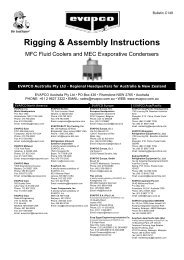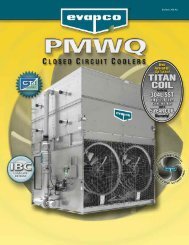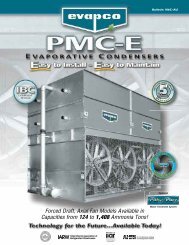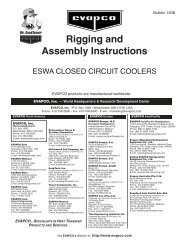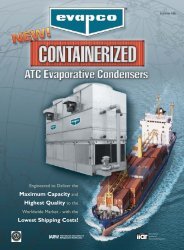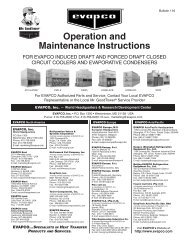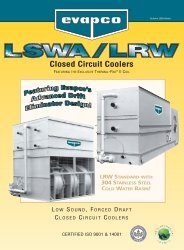For Evapco Fibreglass Cooling Towers, Closed ... - EVAPCO.com.au
For Evapco Fibreglass Cooling Towers, Closed ... - EVAPCO.com.au
For Evapco Fibreglass Cooling Towers, Closed ... - EVAPCO.com.au
Create successful ePaper yourself
Turn your PDF publications into a flip-book with our unique Google optimized e-Paper software.
System Off / No Load<br />
Operation and Maintenance Instructions<br />
The system pump turns off. The starter interlock will energize any optional basin heaters in cold weather.<br />
The recirculation pump should not be used as a means of capacity control, and should not be cycled<br />
frequently. Excessive cycling can lead to scale build-up, and reduce wet and dry performance.<br />
Bypass Mode<br />
During winter months when cooling load is minimal, bypass mode may be used as a form of capacity<br />
control. Bypass mode allows the water to “bypass” the towerʼs water distribution system and deposits the<br />
inlet water directly into the cold water basin. Alternatively, the in<strong>com</strong>ing water bypass can be piped directly<br />
to the return condenser header pipe. Please note: The location of the bypass valve should be 15 feet below<br />
the cooling tower cold water basin elevation to assure proper operation and prevent cavitation. This bypass<br />
mode should be continued until the total water inventory reaches an acceptable temperature level (usually<br />
about 80°F), at which time the bypass may be closed to c<strong>au</strong>se total flow over the fill. <strong>EVAPCO</strong> does NOT<br />
re<strong>com</strong>mend a partial water bypass due to the potential for freezing the heat transfer media during low<br />
ambient operation.<br />
Optional Defrost Cycle<br />
In more severe climates, the incorporation of a defrost cycle may be used to manage the ice formation in<br />
and on the unit. During the defrost cycle, the cooling tower fan(s) are reversed at no more than half speed<br />
while the system pump flows water through the cooling towerʼs water distribution system. Operating the unit<br />
in “reverse” will melt any ice that has formed in the unit or on the intake louvers. All multi-speed or VFD<br />
duty motors supplied by <strong>EVAPCO</strong>, whether for standard belt drive or optional gear drive induced draft units,<br />
are capable of reverse operation.<br />
Defrost cycles are NOT re<strong>com</strong>mended for forced draft cooling towers. In these units, allowing the leaving<br />
water temperature set point to rise c<strong>au</strong>ses the fans to be off for very long periods of time, which increases<br />
the fan drive <strong>com</strong>ponent potential for freezing. In lieu of a defrost cycle, forced draft units should be<br />
operated at low speed (with a 2-speed motor) or minimum speed (no lower than 25% with a variable<br />
frequency drives) in order to maintain positive pressure inside the unit to help prevent ice formation on the<br />
fan drive <strong>com</strong>ponents.<br />
NOTE: MINIMUM CONTROL POINT FOR WATER SHOULD NEVER BE LOWER THAN 5.5 ºC.<br />
Basic <strong>Closed</strong> Circuit Cooler / Evaporative Condenser Sequence of<br />
Operation<br />
System Off / No Load<br />
The system pumps and fans are idle. If the basin is full of water it must be maintained at 5.5 ºC or greater<br />
to prevent freezing. In some climates it may be necessary to use basin water heaters. See the “Cold<br />
Weather Operation” section of this bulletin for more details on cold weather operation and maintenance.<br />
System / Condensing Temperature Rises<br />
The spray pump(s) energises. The unit provides approximately 10% of cooling capacity with the spray<br />
pump energised and the fan idle. If the unit has closure dampers they should be fully opened before the<br />
spray pump(s) be<strong>com</strong>e energised.<br />
As the system temperature continues to rise the fan is energised. <strong>For</strong> a system having variable speed fan<br />
control, the fans begin at minimum speed. See the “Fan System Capacity Control” section of this bulletin for<br />
more details on fan speed control options. The fan speed increases with increasing system heat load.<br />
Page 12 of 34 www.evapco.<strong>com</strong>.<strong>au</strong> sales@evapco.<strong>com</strong>.<strong>au</strong>



